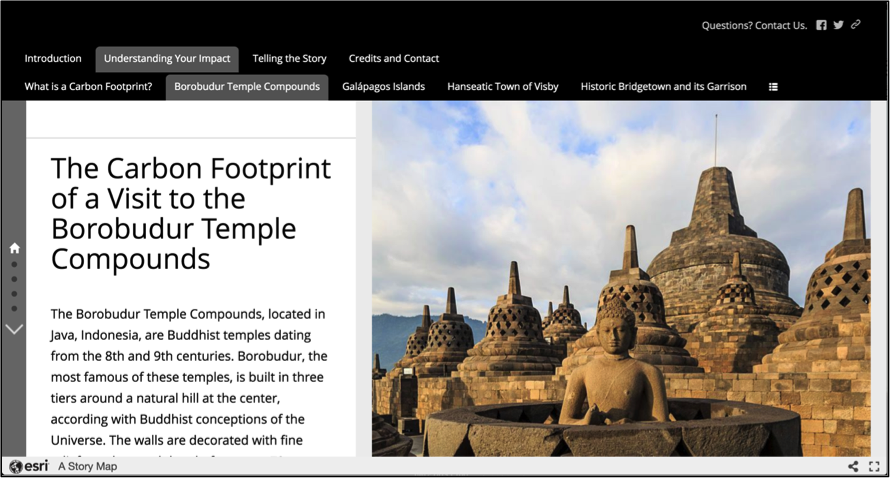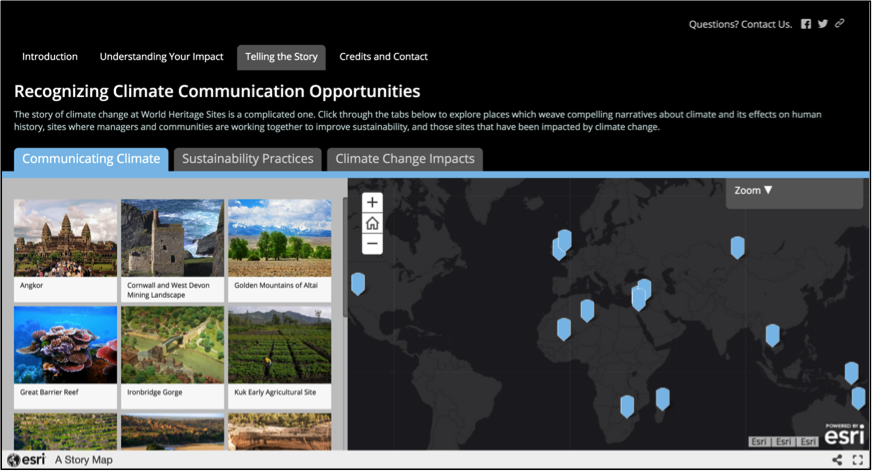A New Online Tool to Understand Climate Change and Cultural Heritage
Ellen Platts
Doctoral Student, Department of Anthropology
University of Maryland
What can heritage teach us about climate change, and how we can take action? This overarching question motivated me and Dr. Kathryn Lafrenz Samuels to develop a new online tool called Climate Footprints of Heritage Tourism. Our title plays on the term ‘carbon footprints,’ illustrating the climate change-related impacts, challenges, and opportunities of tourism at UNESCO World Heritage Sites. The tool is designed to inform policymakers, site managers, and tourists about how the climate crisis is already affecting their lives, how they might be contributing to this crisis, and what can be done to mitigate and adapt to climate change. In the form of an ArcGIS StoryMap, the tool provides an easily accessible, understandable, and compelling platform for communication.

Since the passage of the World Heritage Convention in 1972, the World Heritage List has grown exponentially, numbering more than 1,100 cultural, natural, and mixed sites. Inclusion on the list is a valuable resource for tourism promoters and operators, who draw upon a site’s recognition to increase tourism revenues, foster economic growth, and brand countries as worthy of international travel.
However, recognition also poses a danger to many World Heritage Sites, because tourism contributes to the primary drivers of climate change – carbon dioxide and other greenhouse gas emissions. Many heritage sites are threatened by climate change, particularly by rising sea levels. This can prompt ‘last chance tourists’ to visit famous sites ‘before they are gone,’ thereby increasing the emissions that hasten those sites’ deterioration. This cycle generates both urgency and opportunity to use World Heritage Sites as vehicles for drawing public awareness and action to the problem of global climate change.
Our tool, which we call a ‘climate communication recognition scheme’ (CCRS), takes inspiration from ecolabels (such as LEED Silver, Gold, and Platinum certification for buildings) to communicate directly to heritage site managers and the traveling public. Ecolabels use a certification process to assign labels to consumer goods, like the designation of fair-trade foods, but they are often one-dimensional and primarily quantitative in their approach.
Unlike other kinds of ecolabels, the CCRS is not focused on economic benefits, or environmental conservation restricted to the site in question. Rather, this governance tool is intended to educate by making use of the prominent platform of World Heritage. Therefore, we take a more holistic response, which considers climate impacts on sites alongside site managers’ own efforts to reduce carbon emissions, and a site’s potential for telling the story of climate change to tourists and the broader public.
The Climate Footprints of Heritage Tourism website presents both quantitative and qualitative data for 50 different sites across the globes. A section titled “Understanding Your Impact” presents the carbon footprint of a tourist’s trip to ten specific sites across the world. We estimate this footprint using an input-output model that uses monetary transactions to approximate all of the material and energy inputs of a product, good, or service, producing an estimate of direct and indirect emissions. To tally the footprint of an entire trip, we added up the cost of lodging, transportation, food, and other vacation activities, and used the model to calculate the associated carbon emissions.

Another section, titled “Telling the Story,” provides a hub of information about climate change impacts, sustainability practices in use at sites, and how sites reflect the history of anthropogenic climate change. Presented in a narrative format, this information draws on the persuasive nature of heritage and aims to help readers understand how climate change is related to their own decisions to visit World Heritage Sites.

Work on the tool is ongoing. We plan to add sites, write further descriptions, advertise to site managers and the public, and link this tool to other efforts around climate change and World Heritage. For now, we hope that you enjoy exploring the tool, which is available at www.heritageofclimate.com.
Further information about the method and theoretical framework for this project can also be found in our recent publication “An Ecolabel for the World Heritage Brand? Developing a Climate Communication Recognition Scheme for Heritage Sites,” available as open-access at https://www.mdpi.com/2225-1154/8/3/38.